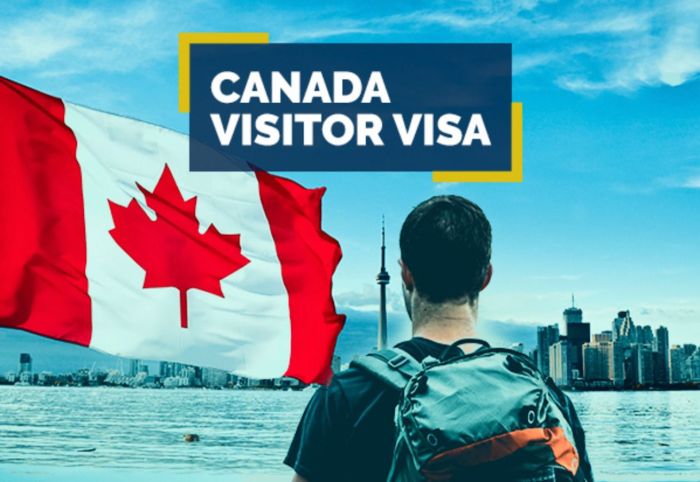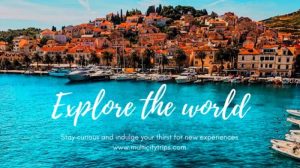
Dreaming of a Canadian adventure? Securing a tourist visa can seem daunting, but navigating the process efficiently is achievable. This guide breaks down the fastest methods to obtain your Canadian tourist visa, highlighting key requirements, application strategies, and factors influencing processing times. We’ll explore both online and paper applications, comparing their respective advantages and disadvantages to help you choose the optimal path for your travel plans.
Understanding the Canadian visa application process is crucial for a smooth and timely experience. From gathering the necessary documentation to completing the application form accurately, every step contributes to a quicker processing time. This guide will provide a clear roadmap, empowering you to confidently navigate the application process and maximize your chances of a swift approval.
Understanding Canadian Tourist Visa Requirements
Securing a Canadian tourist visa involves understanding specific eligibility criteria and meticulously gathering the necessary documentation. This process, while potentially intricate, becomes manageable with a clear understanding of the requirements and a well-organized approach. Failure to meet these requirements can lead to delays or visa rejection.
Eligibility for a Canadian tourist visa hinges on demonstrating to the visa officer that you are a genuine visitor who intends to leave Canada at the end of your authorized stay. This involves proving your ties to your home country, sufficient funds to support yourself during your trip, and a credible travel itinerary. The visa officer assesses your application holistically, considering all factors presented.
Eligibility Criteria for a Canadian Tourist Visa
To be eligible for a Canadian tourist visa, applicants must meet several key criteria. These criteria aim to ensure that visitors pose no risk to Canada’s immigration system and have the means to support themselves during their stay. Applicants must demonstrate a clear purpose for their visit, sufficient financial resources, and strong ties to their home country that incentivize their return.
Failure to convincingly demonstrate these elements can result in visa denial.
Required Documentation for a Canadian Tourist Visa Application
The documentation required for a Canadian tourist visa application varies depending on individual circumstances, but generally includes the following essential elements. Providing comprehensive and accurate documentation is crucial for a successful application. Incomplete or misleading information can lead to delays or rejection.
Applicants should gather the following:
- A completed and signed application form.
- A valid passport with at least six months of validity remaining beyond your intended stay in Canada.
- Proof of sufficient funds to cover your travel expenses, such as bank statements, pay stubs, or sponsorship letters.
- A detailed travel itinerary, including flight reservations, accommodation bookings, and planned activities.
- A letter of invitation from a host in Canada (if applicable).
- Proof of ties to your home country, such as employment contracts, property ownership documents, or family ties.
- A recent passport-sized photograph meeting specific requirements.
- Biometrics (fingerprints and photograph) may be required depending on your nationality and application location.
Step-by-Step Guide on Completing the Application Form
The Canadian tourist visa application form requires careful and accurate completion. Inaccuracies or omissions can lead to delays or rejection. It’s advisable to thoroughly review the instructions before starting the application. Many applicants find it helpful to complete a draft before submitting the final version.
The application process typically involves:
- Accessing the online application form through the official Immigration, Refugees and Citizenship Canada (IRCC) website.
- Creating an online account and providing personal information accurately.
- Carefully answering all questions in the application form, ensuring accuracy and completeness.
- Uploading all required supporting documents in the specified formats.
- Paying the applicable visa application fees.
- Submitting the completed application and receiving a confirmation number.
Application Checklist
A comprehensive checklist ensures all necessary documents are included, minimizing the risk of delays. Thoroughly reviewing this checklist before submitting your application is highly recommended.
Before submitting your application, verify that you have:
- Completed application form
- Valid passport
- Proof of sufficient funds
- Detailed travel itinerary
- Letter of invitation (if applicable)
- Proof of ties to home country
- Passport photograph
- Biometrics (if required)
Fastest Application Methods

Applying for a Canadian tourist visa involves a choice between two primary methods: submitting an application online or through a paper-based process. Both methods lead to the same outcome – a visa decision – but differ significantly in their convenience, speed, and overall experience. Understanding these differences is crucial for applicants aiming to expedite their visa acquisition.Choosing the right application method depends on individual circumstances and priorities.
While the online application generally offers a faster processing time, it requires a certain level of technological proficiency and access to reliable internet. The paper application, although potentially slower, might be preferable for those who are less comfortable with online forms or lack consistent internet access.
Online vs. Paper Application: A Comparison
The most significant difference between the online and paper application methods lies in processing times. The online system, designed for efficiency, often processes applications more quickly. However, processing times can still vary depending on individual circumstances and the volume of applications received by the Canadian visa office. The paper application method, involving physical document submission and manual processing, typically takes considerably longer.
| Application Method | Processing Time (Estimate) | Advantages | Disadvantages |
|---|---|---|---|
| Online Application | 8 weeks (average), but can be faster or slower depending on individual circumstances. Some applicants report processing times as short as 4 weeks, while others may experience delays. | Faster processing (generally), easier tracking of application status, convenient submission. | Requires internet access and digital literacy, potential for technical issues. |
| Paper Application | 12-16 weeks (or longer), subject to significant variation based on visa office workload and individual circumstances. | Suitable for those with limited digital access or technological skills. | Slower processing, less convenient, more prone to delays due to postal services and manual handling. |
Fastest Application Method: Online Application Flowchart
The online application process is generally the faster option. The following flowchart illustrates the key steps involved:[Diagram description: The flowchart would begin with a box labeled “Start.” An arrow would point to a box labeled “Gather Required Documents (Passport, Photos, etc.).” Another arrow would lead to “Complete Online Application Form.” A subsequent arrow would point to “Pay Application Fees Online.” The next box would be “Upload Supporting Documents.” An arrow then leads to “Submit Application.” Another arrow points to “Application Review and Processing.” The next box would be “Visa Approval/Refusal Notification (via email).” Finally, an arrow leads to the “End” box.
The flowchart visually depicts a linear process, emphasizing the straightforward nature of the online application method.]
Factors Affecting Processing Time

The speed at which your Canadian tourist visa application is processed depends on several interconnected factors. Understanding these factors can help you manage your expectations and potentially expedite the process. While the Canadian government aims for efficiency, various circumstances can influence the overall timeline.Several key elements significantly impact processing times. These include the completeness of your application, the accuracy of the information provided, and the supporting documentation submitted.
Each of these aspects plays a crucial role in determining how quickly your application moves through the system.
Application Completeness
A complete application is paramount for swift processing. Submitting a missing document or an incomplete form can lead to delays as the visa officer requests further information. This back-and-forth communication can significantly extend the processing time. For example, if you fail to submit proof of sufficient funds, your application will be flagged for review, delaying the process until the required documentation is received.
A complete application demonstrates preparedness and respect for the process, potentially leading to faster review.
Accuracy of Information
Providing accurate and truthful information is not merely a formality; it’s essential for a smooth and efficient application process. Inaccuracies or inconsistencies can trigger further scrutiny and investigations, significantly delaying the processing time. For instance, a discrepancy between your stated employment history and official documentation will necessitate verification, delaying your application. Ensuring the accuracy of all details from the outset streamlines the process and minimizes the likelihood of delays.
Supporting Documentation
Adequate supporting documentation is crucial for a quick processing time. The supporting documents must be relevant, verifiable, and clearly demonstrate that you meet all the visa requirements. For example, providing a detailed travel itinerary, confirmed flight and accommodation bookings, and proof of sufficient funds will significantly strengthen your application and increase the chances of a speedy approval. Conversely, a lack of supporting documents or documents that are difficult to verify can lead to delays while the visa officer requests additional information.
Strong supporting documentation shows you are a serious applicant, prepared for the trip, and less likely to overstay your visa.
Travel Hacks for Canadian Trips
Planning a trip to Canada can be exciting, but managing the costs effectively is key to a truly enjoyable experience. This section provides practical tips and strategies to help you maximize your travel budget and make the most of your Canadian adventure. We’ll cover ways to save on flights, find affordable accommodation, and explore some must-see attractions.
Saving Money on Flights to Canada
Securing affordable flights is crucial for any trip. Several strategies can significantly reduce airfare costs.
- Book in Advance: Generally, booking flights several months in advance, especially during the off-season, offers better prices. Airlines often release cheaper fares earlier to fill seats.
- Be Flexible with Dates: Consider traveling mid-week or during the shoulder seasons (spring and fall) for potentially lower fares. Weekends and peak summer months tend to be more expensive.
- Use Flight Comparison Websites: Websites like Google Flights, Skyscanner, and Kayak allow you to compare prices from various airlines and travel agencies simultaneously, helping you find the best deals.
- Consider Budget Airlines: Budget airlines sometimes offer significantly cheaper fares, but remember to factor in potential extra baggage fees and other add-ons.
- Clear Your Browser History: Airlines and travel websites sometimes track your searches and may increase prices based on your browsing history. Clearing your cache and cookies can help you avoid this.
Finding Affordable Accommodation in Canada
Accommodation costs can significantly impact your budget. Here are some effective ways to find affordable options.
- Hostels: Hostels are a great option for budget travelers, offering dorm rooms and private rooms at lower prices than hotels. They also provide a great opportunity to meet fellow travelers.
- Airbnb and VRBO: These platforms offer a wide range of private rentals, from apartments to entire houses, often at more competitive prices than hotels, especially for longer stays. You can find options in various neighborhoods and locations to suit your preferences.
- Consider Locations Outside Major Cities: Staying in smaller towns or suburbs near major cities can offer significantly cheaper accommodation while still providing easy access to attractions.
Must-See Attractions in Canada
Canada boasts a diverse range of breathtaking landscapes and iconic landmarks. Here are five must-see attractions, categorized by region:
- British Columbia: Banff National Park, renowned for its stunning turquoise lakes, towering mountains, and abundant wildlife. Imagine hiking amidst pristine scenery, taking a scenic gondola ride, or simply relaxing by the crystal-clear waters of Lake Louise.
- Alberta: Lake Louise and Moraine Lake within Banff National Park. These iconic glacial lakes offer unforgettable views and opportunities for photography and kayaking.
- Ontario: Niagara Falls, a natural wonder that captivates visitors with its immense power and beauty. Consider taking a boat tour to get up close to the falls or exploring the surrounding area.
- Quebec: Old Quebec City, a UNESCO World Heritage site, features charming cobblestone streets, historic architecture, and a rich cultural heritage. Explore the Citadelle, walk along the ramparts, and savor the city’s unique atmosphere.
- Nova Scotia: Cabot Trail, a scenic coastal highway offering breathtaking views of the Atlantic Ocean, charming fishing villages, and lush landscapes. The drive itself is an adventure, with opportunities for hiking, whale watching, and exploring local communities.
Sample 10-Day Canadian Itinerary
This itinerary focuses on exploring Western Canada, balancing iconic sights with opportunities for relaxation and exploration.
Day 1-3: Vancouver, British Columbia: Arrive in Vancouver, explore Stanley Park, Granville Island Market, and Gastown. Consider a whale watching tour.
Day 4-6: Banff National Park, Alberta: Travel to Banff (train or rental car recommended). Explore Lake Louise, Moraine Lake, and Johnston Canyon. Hike, kayak, or simply enjoy the stunning mountain scenery.
Day 7-8: Calgary, Alberta: Travel to Calgary. Visit the Calgary Tower, explore the city’s vibrant downtown, and perhaps visit the Calgary Stampede (if timing aligns).
Day 9: Travel Day: Fly or take a train from Calgary to your departure city.
Day 10: Departure: Depart from your chosen airport.
Travel Photography Tips for Canada
Canada’s breathtaking landscapes and diverse wildlife offer unparalleled photographic opportunities. From majestic mountains to vibrant cityscapes, capturing the essence of this vast country requires careful planning and execution. This section provides practical tips to enhance your Canadian photography experience.
Capturing Stunning Landscapes
To capture truly stunning Canadian landscapes, consider these key elements: Composition, lighting, and the use of leading lines are crucial for creating impactful images.
- Rule of Thirds: Instead of centering your subject, place it along one of the imaginary lines that divide your frame into thirds, both horizontally and vertically. This creates a more balanced and visually appealing composition.
- Golden Hour and Blue Hour: Shoot during the golden hour (sunrise and sunset) for warm, soft light that enhances colours and creates long shadows. The blue hour (twilight) offers a cool, moody atmosphere perfect for capturing dramatic scenes.
- Leading Lines: Utilize natural elements like rivers, roads, or fences to guide the viewer’s eye towards your main subject. This adds depth and visual interest to your photograph.
- Depth of Field: Experiment with aperture settings to control depth of field. A wide aperture (low f-stop number) creates a shallow depth of field, blurring the background and emphasizing your subject. A narrow aperture (high f-stop number) keeps both foreground and background in sharp focus.
- Filters: Utilize a polarizing filter to reduce glare and enhance colours, particularly in landscapes with water or sky. A graduated neutral density filter can balance exposure between bright skies and darker foregrounds.
Photographing Canadian Wildlife
Wildlife photography in Canada requires patience, respect, and awareness of safety guidelines. Maintaining a safe distance and respecting the animals’ natural behaviour is paramount.
- Patience and Observation: Wildlife photography requires patience. Spend time observing animals in their natural habitat to anticipate their movements and capture candid moments.
- Long Lenses and High ISO: Use a telephoto lens to get closer to animals without disturbing them. A high ISO setting allows for faster shutter speeds, crucial for capturing sharp images of moving animals in low-light conditions.
- Understanding Animal Behaviour: Research the behaviour of the animals you intend to photograph. Knowing their typical routines and habitats will increase your chances of capturing compelling images.
Iconic Canadian Locations for Photography
Canada boasts numerous iconic locations perfect for photography. Each location offers unique photographic opportunities, depending on the season and time of day.
- Banff National Park, Alberta: Famous for its turquoise lakes, towering mountains, and abundant wildlife.
- Niagara Falls, Ontario: The powerful falls provide dramatic scenes, especially during the golden hour or at night with the illumination.
- Moraine Lake, Alberta: The vibrant blue waters of Moraine Lake, nestled within the Valley of the Ten Peaks, are a photographer’s dream.
- Peggy’s Cove, Nova Scotia: The picturesque lighthouse and rugged coastline offer iconic images of Atlantic Canada.
- Old Quebec City, Quebec: The historic streets, charming architecture, and cobblestone lanes provide a wealth of photographic opportunities.
Best Time of Day for Photography in Different Environments
The ideal time for photography varies depending on the environment and the desired effect.
Generally, the golden hour (sunrise and sunset) provides the most flattering light for most landscapes, creating warm tones and long shadows. However, midday sun can be harsh, resulting in high contrast and washed-out colours. In forests, the diffused light of overcast days can be advantageous, eliminating harsh shadows and creating even illumination. For wildlife photography, early morning and late evening often offer the best opportunities, as animals are most active during these times.
Night photography, particularly in urban settings, can yield dramatic and unique results.
Additional Travel Tips for Canada
Planning a trip to Canada involves more than just securing a visa; understanding the nuances of travel within the country is crucial for a smooth and enjoyable experience. This section offers practical advice on navigating public transport, prioritizing safety, essential packing, and understanding Canadian customs and etiquette.
Navigating Public Transportation in Canadian Cities
Efficient and reliable public transportation systems are available in most major Canadian cities. Understanding these systems can significantly enhance your travel experience and save you money.
- Purchase transit passes: Many cities offer day passes or multi-day passes that provide unlimited travel and are generally more cost-effective than individual fares. Look for options like Presto cards (Toronto) or Compass cards (Vancouver).
- Utilize trip planning apps: Apps like Google Maps or Citymapper can provide real-time information on schedules, routes, and potential delays, helping you plan your journey efficiently.
- Understand fare payment systems: Familiarize yourself with the various methods of payment accepted on public transport, such as tap cards, mobile payment apps, or tickets purchased from vending machines.
- Be mindful of rush hour: Avoid traveling during peak hours if possible, as public transport can become crowded and potentially slower.
- Check for service disruptions: Before setting out, it’s always wise to check the transit agency’s website or app for any planned service disruptions or delays.
Staying Safe While Traveling in Canada
Canada is generally a safe country, but taking precautions is always advisable.
- Be aware of your surroundings: Pay attention to your belongings and avoid walking alone in poorly lit or deserted areas, especially at night. This is a general safety precaution applicable to most urban areas globally.
- Inform someone of your itinerary: Let a friend or family member know your travel plans, including your accommodation details and expected return time. This ensures someone is aware of your whereabouts.
- Register with your embassy or consulate: Some countries advise citizens to register their travel plans with their embassy or consulate in Canada. This can be helpful in case of emergencies.
Essential Items to Pack for a Trip to Canada
Packing appropriately for Canada’s varied climate is key to a comfortable trip.
- Layers of clothing: Canada experiences significant temperature variations, particularly between seasons and regions. Packing layers allows you to adapt to changing conditions.
- Comfortable walking shoes: You’ll likely be doing a lot of walking, so comfortable shoes are a must. Consider waterproof boots if traveling during wetter months.
- Appropriate outerwear: A warm coat, hat, gloves, and scarf are essential, especially during colder months. The severity of winter varies significantly across the country.
- Universal travel adapter: Canada uses Type A and Type B plugs. A universal adapter will ensure your electronics can be charged.
- Travel insurance: Comprehensive travel insurance is highly recommended to cover unexpected medical expenses, trip cancellations, or lost belongings.
Canadian Customs and Etiquette
Understanding Canadian customs and etiquette will enhance your interactions with locals and contribute to a more positive travel experience.
- Politeness and courtesy: Canadians generally value politeness and courtesy. Saying “please” and “thank you” goes a long way. A friendly demeanor is generally appreciated.
- Tipping: Tipping is customary in restaurants (15-20%), bars, and for taxi services. Service charges are sometimes included in bills; check carefully.
- Public spaces: Be mindful of noise levels in public spaces, particularly in residential areas. Respect quiet hours and avoid loud conversations or disruptive behavior.
Urban Escapes in Canada
Canada’s vibrant cities offer a diverse range of experiences, from cosmopolitan hubs to charming historic centres. Exploring these urban landscapes provides a fascinating glimpse into Canadian culture, history, and modern life. This section highlights three unique urban experiences, focusing on optimal visiting times and local highlights.
Montreal: A European Flair in North America
Montreal, Quebec, boasts a unique European charm blended with North American dynamism. Its cobblestone streets, French-language culture, and stunning architecture create a captivating atmosphere. The best time to visit Montreal is during the summer (June-August) for pleasant weather, outdoor festivals, and vibrant street life. However, a visit during the winter (December-February) offers a magical experience with snow-covered streets, ice skating rinks, and the enchanting Montreal Winter Festival.Local Events: Montreal hosts numerous festivals throughout the year, including the Montreal International Jazz Festival (June-July), the Just for Laughs comedy festival (July), and the Montreal en Lumière winter festival (February).Recommended Restaurants:
- Toqué!: A fine-dining establishment showcasing innovative, seasonal Quebec cuisine.
- Joe Beef: A renowned restaurant known for its lively atmosphere and delicious, unpretentious food.
- Schwartz’s Deli: A Montreal institution famous for its smoked meat sandwiches.
Toronto: A Cosmopolitan Metropolis
Toronto, Ontario, is Canada’s largest city, a bustling metropolis with a diverse population and a vibrant cultural scene. The best time to visit Toronto is during the summer (June-August) to enjoy the city’s numerous parks, outdoor events, and warm weather. Autumn (September-October) also offers a beautiful experience with vibrant fall foliage.Local Events: Toronto hosts many festivals, including the Canadian National Exhibition (late August-early September), the Toronto International Film Festival (September), and the Caribana festival (July).Recommended Restaurants:
- Pai Northern Thai Kitchen: Authentic and delicious Northern Thai cuisine in a stylish setting.
- Canoe: Fine dining with stunning panoramic views of the city from its location atop the TD Bank Tower.
- St. Lawrence Market: A historic marketplace offering a wide variety of food vendors and local produce.
Vancouver: Coastal Beauty and Urban Chic
Vancouver, British Columbia, is a stunning coastal city surrounded by mountains and ocean. Its natural beauty combined with its modern urban landscape makes it a unique destination. The best time to visit Vancouver is during the summer (June-August) for pleasant weather and opportunities for outdoor activities like hiking and kayaking. Spring (April-May) offers milder temperatures and fewer crowds.Local Events: Vancouver hosts many festivals, including the Vancouver International Film Festival (September-October), the Celebration of Light fireworks festival (July), and the Vancouver Folk Music Festival (July).Recommended Restaurants:
- Hawksworth Restaurant: A sophisticated fine-dining restaurant showcasing contemporary Canadian cuisine.
- Miku Restaurant: Known for its innovative and delicious Aburi-style sushi.
- Medina Café: A popular spot for its Mediterranean-inspired cuisine and vibrant atmosphere.
Vacation Packages and Programs
Planning a trip to Canada can be overwhelming, but thankfully, numerous vacation packages cater to diverse interests and budgets. These packages offer a convenient way to bundle flights, accommodation, and sometimes activities, simplifying the travel planning process. Understanding the different types available allows travelers to choose the option best suited to their needs and preferences.
Pre-packaged vacations offer both advantages and disadvantages. The primary benefit lies in convenience; everything is organized beforehand, minimizing stress and maximizing enjoyment. However, a lack of flexibility can be a drawback; pre-determined itineraries might not perfectly align with individual preferences. The cost is another factor to consider; while some packages offer excellent value, others might be more expensive than booking components separately.
Types of Canadian Vacation Packages
Canadian vacation packages vary widely, catering to a broad spectrum of traveler preferences. They range from budget-friendly options focusing on major cities to luxurious all-inclusive resorts and adventurous expeditions into the Canadian wilderness. The choice depends largely on individual travel style, budget, and desired experiences.
| Package Type | Description | Benefits | Drawbacks | Example |
|---|---|---|---|---|
| City Break | Focuses on exploring major cities like Toronto, Montreal, or Vancouver. Often includes flights and hotel stays. | Convenient for urban exploration, access to city attractions. | Limited exposure to Canada’s natural beauty, can be expensive depending on the city and time of year. | A three-day trip to Toronto including flights and a hotel stay near the CN Tower. |
| National Parks Tour | Features visits to several national parks, often including guided tours and accommodation within or near the parks. | Immersive experience of Canada’s natural landscapes, access to hiking trails and wildlife viewing opportunities. | Can be physically demanding, requires more travel time between locations. | A ten-day tour visiting Banff, Jasper, and Yoho National Parks, including guided hikes and accommodation in park lodges. |
| Adventure Tour | Offers activities like white-water rafting, kayaking, hiking, or skiing, often in remote locations. | Thrilling experiences, access to unique landscapes, opportunity for personal growth. | Can be physically demanding and potentially risky, requires a certain level of fitness. | A week-long white-water rafting trip down the Fraser River in British Columbia. |
| Cultural Immersion Program | Focuses on experiencing Canadian culture through activities like cooking classes, indigenous cultural tours, or visits to historical sites. | Deep understanding of Canadian culture and history, opportunity for interaction with locals. | Might require more independent exploration, less emphasis on relaxation. | A five-day program in Quebec City, including French cooking classes and visits to historical landmarks. |
| All-Inclusive Resort Stay | Offers accommodation, meals, and activities at a resort, typically located in a scenic area. | Relaxing and convenient, all-inclusive pricing simplifies budgeting. | Limited exploration outside the resort, can be less authentic than other options. | A week-long stay at a resort in Whistler, British Columbia, including skiing, snowboarding, and access to spa facilities. |
Popular Vacation Programs in Canada
Numerous companies offer structured vacation programs throughout Canada. These programs often provide a curated experience, removing the need for extensive independent planning. They vary significantly in focus, from adventure-based activities to culturally immersive experiences.
For example, Intrepid Travel offers various adventure tours across Canada, focusing on hiking, kayaking, and wildlife viewing. G Adventures provides a range of cultural tours, including indigenous experiences and explorations of Canada’s diverse cities. These programs often include transportation, accommodation, and guided excursions, providing a comprehensive travel experience.
Venture Capital and Tourism
Venture capital (VC) is increasingly playing a significant role in shaping the Canadian tourism sector, injecting much-needed funds into innovative businesses and fostering growth within a traditionally less tech-focused industry. This influx of capital is transforming how tourism experiences are designed, marketed, and delivered, ultimately enhancing the visitor experience and boosting the Canadian economy.The Canadian tourism industry, while vast and diverse, presents numerous opportunities for venture capitalists seeking high-growth potential.
The sector’s inherent resilience, coupled with the increasing demand for unique and sustainable travel experiences, makes it an attractive investment landscape. VC funding is not just about providing capital; it also brings expertise in scaling businesses, strategic planning, and navigating complex market dynamics, all vital for success in the competitive tourism world.
Tourism-Related Businesses Attracting Venture Capital
Several types of tourism-related businesses are particularly appealing to venture capitalists. These businesses often exhibit characteristics like scalability, strong growth potential, and a defensible business model. They are often technology-driven, leveraging data analytics and innovative platforms to improve efficiency and customer experience.Examples include businesses focused on sustainable and eco-friendly tourism, offering unique and immersive experiences catering to the growing segment of conscious travellers.
Another attractive area is the development of innovative tourism technology platforms, such as online booking systems, personalized travel planning tools, and virtual reality experiences that enhance the pre-trip planning and in-destination experiences. Finally, businesses focused on improving the efficiency and sustainability of tourism operations, such as optimizing transportation networks or developing smart city solutions for tourist destinations, are also attracting significant investment.
Impact of Venture Capital on the Canadian Tourism Industry
The infusion of venture capital into the Canadian tourism sector has several potential impacts. Firstly, it fuels innovation, leading to the development of new products, services, and experiences that cater to evolving consumer preferences. This can range from creating hyper-personalized travel itineraries using AI to developing sustainable tourism initiatives that minimize environmental impact. Secondly, VC investment stimulates job creation, not only within the funded businesses themselves but also throughout the supporting industries.
Thirdly, increased investment can improve the overall efficiency and competitiveness of the Canadian tourism industry on the global stage, allowing it to better compete with other international destinations.For example, a company specializing in sustainable adventure tourism, leveraging technology for efficient booking and resource management, might secure VC funding, allowing it to expand its operations across multiple national parks, creating numerous jobs and showcasing Canada’s natural beauty in a responsible manner.
Similarly, a tech startup developing a virtual reality platform for exploring Canadian cities could attract investment, leading to job creation in software development, marketing, and content creation, while simultaneously enhancing the tourism experience.
Venture Capitalist Investment Criteria
Venture capitalists employ rigorous criteria when evaluating tourism-related investment opportunities. They typically assess the size and growth potential of the target market, the strength and scalability of the business model, the experience and competence of the management team, and the overall financial viability of the venture. A strong emphasis is also placed on the business’s ability to generate positive social and environmental impact, aligning with the increasing demand for sustainable and responsible tourism practices.Furthermore, VCs look for businesses with a clear path to profitability, a strong brand identity, and a demonstrable understanding of the competitive landscape.
They also conduct thorough due diligence to assess potential risks and ensure that the investment aligns with their overall portfolio strategy and risk tolerance. Ultimately, the decision to invest rests on a comprehensive evaluation of the business’s potential to deliver strong returns while contributing positively to the Canadian tourism ecosystem.
Obtaining a Canadian tourist visa efficiently involves understanding the requirements, choosing the right application method, and ensuring a complete and accurate submission. By following the strategies Artikeld in this guide, prospective visitors can significantly increase their chances of a quick approval and embark on their Canadian journey sooner. Remember to plan ahead, gather all necessary documentation, and utilize the fastest application method available to you.
Your Canadian adventure awaits!
Popular Questions
What happens if my application is incomplete?
An incomplete application will significantly delay processing. You’ll likely be asked to provide missing information, extending the overall timeframe.
Can I track my application status?
Yes, most online applications provide a tracking number allowing you to monitor the progress of your application.
How long is a Canadian tourist visa valid for?
The validity period varies depending on the visa officer’s assessment, typically ranging from six months to ten years.
What if my visa is denied?
If your visa is denied, you will receive notification explaining the reasons. You may be able to reapply, addressing the concerns raised in the denial letter.






